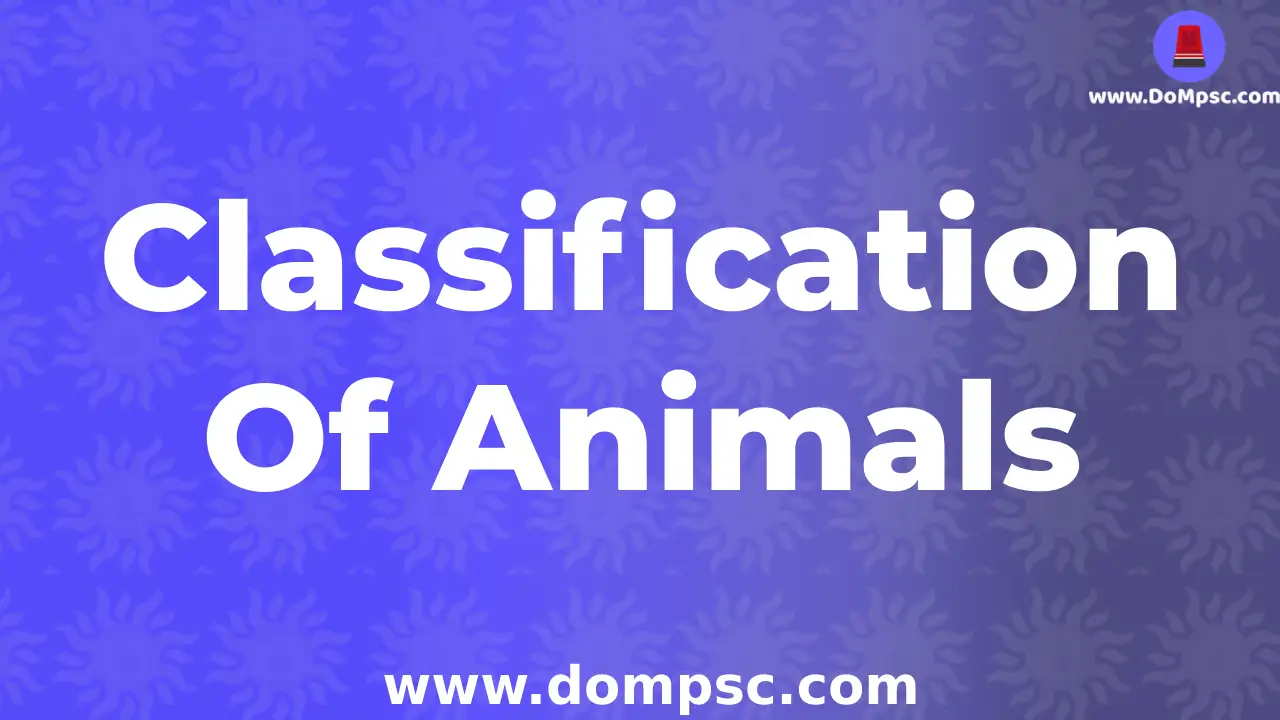MPSC Classification of animals(प्राण्यांचे वर्गीकरण)-MPSC Biology science notes

✪ Download pdf Works Properly on chrome Browser ✪
Classification of animals(प्राण्यांचे वर्गीकरण)
Table Of Contain-Mpsc Classification of animals
Intro-Classification of animals

By Shubham Vyawahare
0-May-2025
➤ He divides the all animal in certain Groups bby considering their different categories.
➤ This categories are like a height,width,reproduction systems.
➤ Further divedation properties is as follow.
✪ Body Structure-Depends on layer of a body.
✪ Body Symmetry-Symmetric or asymmetric structure.
✪ Body Cavity-Is Cavity present or not.
✪ Organ OF locomotion-What they used to locate .
✪ origins of the mouth and anus
✪ vertebrates or invertebrates
✪ Types Of animals ✪
1.Periphera
➤Animals Having holes on a body.
➤sponge Animals.
➤They Found in a marine water.
➤ There are two holes on a body.
➤ Ostia Work as a mouth.
➤ osculum Work as a anus.
➤ They have no organs in their body.
➤ They depict cellular grade of organization.
➤ The central cavity is called spongocoel or atrium which opens to the outside through the osculum
➤ They reproduce asexually by budding, and fragmentation.
➤ The nutrition is holozoic.
➤ Types With Examples Are
Calcarea
➤ They are found in marine, shallow, and coastal water.
➤ The body is cylindrical and exhibits radial symmetry.
➤ The body organization is asconoid, syconoid, or leuconoid.
➤ Eg., Clathrina, Scypha
Hexactinellids
➤ They are found in marine and the deep sea.
➤The skeleton is made up of six-rayed siliceous spicules.
➤ The body is cylindrical in shape and exhibit radial symmetry.
➤ The canal system is Sycon or Leucon.
➤ Eg., Euplectella, Hyalonema
Desmospongiae
➤ They are found in marine or freshwater.
➤ The body is asymmetrical and cylindrical in shape.
➤ The canal system is a leuconoid type.
➤ The skeleton comprises spongin fibres, siliceous spicules, which are monoaxon and triaxon.
➤ Eg: Spongia, Spongilla, etc.
2.Coelenterata
➤ Generally Found in Sea.
➤They have Radial Symmetry.
➤ They have Body cavity.
➤ They do a reproduction by budding method.
➤ Divedation of Coelenterata further divided in.
Anthozoa
➤ includes true corals, anemones, and sea pens;.
Cubozoa
➤ the amazing box jellies with complex eyes and potent toxins.
Hydrozoa
➤ the most diverse group with siphonophores, hydroids, fire corals, and many medusae.
Scyphozoa
➤ the true jellyfish.3.platyhelminthes
➤The body has a soft covering with or without cilia..
➤hey are triploblastic, acoelomate, and bilaterally symmetrical..
➤ they have symmetric right and left sides and usually a definite head.
➤ they have organ systems, including an excretory, digestive,
Trematoda
➤ The class Trematoda consists of flukes
➤They spread infection and disease in humans and animals.
Cestoda
➤ Over 1,500 species of tapeworms make up the class Cestoda.
➤ Tapeworms are parasitic flatworms that invade the intestinal tracts of animals and humans and are capable growing up to 75 feet long
Turbellaria
➤ found in fresh water, saltwater, and, less often, moist soil.
➤ They can also move short distances using a brisk crawling motion
➤ They feed on protozoa, bacteria, crustaceans, smaller worms, and animal and plant matter
4.Nemathelminthes OR Aschelminthes
➤ Bilaterally symmetrical..
➤ Body is unsegmented.
➤It is a phylum of unsegmented, triploblastic, pseudocoelomic, cylindrical or thread-like worms which are covered by a body wall having cuticle and epidermis.. ➤ They are commonly called thread worm or round worm.
➤ Body is covered with tough and resistant cuticle.
➤ Nervous system is not much developed.
➤ Example- thread,worm,Eyeworm,Hookworm,Whipworm.
5. Annelida
➤ Having over 17,000 species, Phylum Annelida is a large phylum..
➤ Annelids are also known as ringworms or segmented worms.
➤ They exist in various environments including marine waters, fresh waters and also in moist terrestrial areas.
➤ The size of the annelids can range from a few millimetres to an amazing three metres in length.
➤ Annelids exhibit bilateral symmetry and are invertebrate organisms.
➤ The body is segmented which is the most distinguishing feature of annelids..
Polychaeta
➤ Polys: many; chaite:hair
➤Bilaterally symmetry, segmented worms..
➤ Fertilization: external
➤ Excretory system: Both metanephridia and protonephridia.
Oligochaeta
➤ (Oligos: few, chaite: hair).
➤Habitat: mostly terrestrial and few are freshwater
➤Hermaphrodite but cross fertilization occur
Hiradinea
➤ found in fresh water, saltwater, and, less often, moist soil.
➤ he body has definite number or segments.
➤ Fertilization: internal and a larval stage is absent.
Archiannelida
➤ They are strictly marine.
➤They may be unisexual or hermaphrodite..
6. Arthropods
➤ Polys: many; chaite:hair
➤Bilaterally symmetry, segmented worms..
➤ The largest phylum in the animal kingdom
➤ 84% percent of all known species of animals are members of this phylum
➤ skeletal covering composed of chitin (a complex sugar) bound to protein. This nonliving exoskeleton is secreted by the underlying epidermis
➤ A unique feature of animals in the arthropod phylum is the presence of a segmented body and fusion of sets of segments that give rise to functional body regions called tagmaa
Hexapoda
➤ Example:Ants, Aphids, Beetles, Butterflies, Cicadas, Cockroaches, Dragonflies, Fleas
Chelicerata
➤Example:lack widow spider Brown recluse Chiggers Crab spiders Daddy longlegs Harvestmen Mites Orb weavers
Crustacea
➤Examples:arnacles Brine shrimp Crabs Crayfish Fish Lice Horseshoe shrimp Krill Lobsters Seed shrimp Shrimp.
Mollusks
➤ They are a source of food as well as jewellery.
➤ Most of them lived in sea.
➤ The hard shells are used to make beautiful jewellery pieces
➤ Pearls that are obtained from bivalves and gastropods are valuable as these pearls are lined with nacre.
➤ Natural pearls are formed when a small foreign object gets stuck in between the mantle and shell of the mollusc..
➤ Further divided into 4 parts.
✪ Gastropods- Gastropods include snails and slugs.
✪ Bivalves-Bivalves include clams, scallops, oysters, and mussels.
✪ Cephalopods-Cephalopods include the octopus and squid.
Cynometra
➤ a genus of ca. 85 species of shrubs to large trees.
➤ It is amongst the largest genera in the legume subfamily Detarioideae and one of the few with a pantropical distribution.
Hemichordata
➤ form a small phylum (only a few hundred species).
➤distinguished by a tripartite (threefold) division of the body.
➤ Body cavity a true coelom..
➤Body possesses a through gut, straight or U-shaped, with an anus..
➤Body possesses a through gut, straight or U-shaped, with an anus..
➤Feeds on fine particles in the water..
➤Nervous system normally diffuse, but variable.
➤ There are only about 90 known species
➤ all of which are benthic (living on the sea floor) in their adult form
Chordata
➤ Vertebrate animal.
* 4 stages in Chordata's life
➤ Notochord:a longitudinal rod that is made of cartilage and runs between the nerve cord and the digestive tract .
➤ Dorsal Nerve Cord:This is a bundle of nerve fibres which connects the brain to the muscles and other organs.
➤ Post-anal tail :extension of the body beyond the anus .
➤ Pharyngeal slits:connect the mouth and the throat..
Others Blogs Related to MPSC Biology Notes
➤Biology Exam Pattern
➤Blood Circulation System
➤Blood Groups And Its Diseases
➤Balanced Diet And Nutrients
➤Classification Of Animals
➤Classification OF Plants
➤Cell
➤Tissue
➤Coordination In Human
➤Digestive System
➤Diseases And Disease Types
➤Excretory System
➤Respiratory System
➤Reproductive System
➤Skeletal System
Read All MPSC blogs
- ➤केंद्र सरकारने खाजगी क्लासेस साठी नवी नियमावली लागू केली आहे |GUIDELINES FOR REGULATION OF COACHING CENTER in marathi
- ➤MPSC Data leak: पेपर न फुटल्याचा दावा MPSC आयोगाने स्पष्टपणे केला आहे
- ➤MPSC hall ticket data leaked before 6 days of exam
- ➤MPSC Data leak: टेलेग्राम वर अचानक ९० हजार परीक्षार्थींचे प्रवेशपत्र झाले लिक
- ➤मराठी भाषेला अभिजात दर्जा मिळायला हवाच , अभिजात दर्जा नेमका कसा मिळतो ?
MPSC Books pdf



